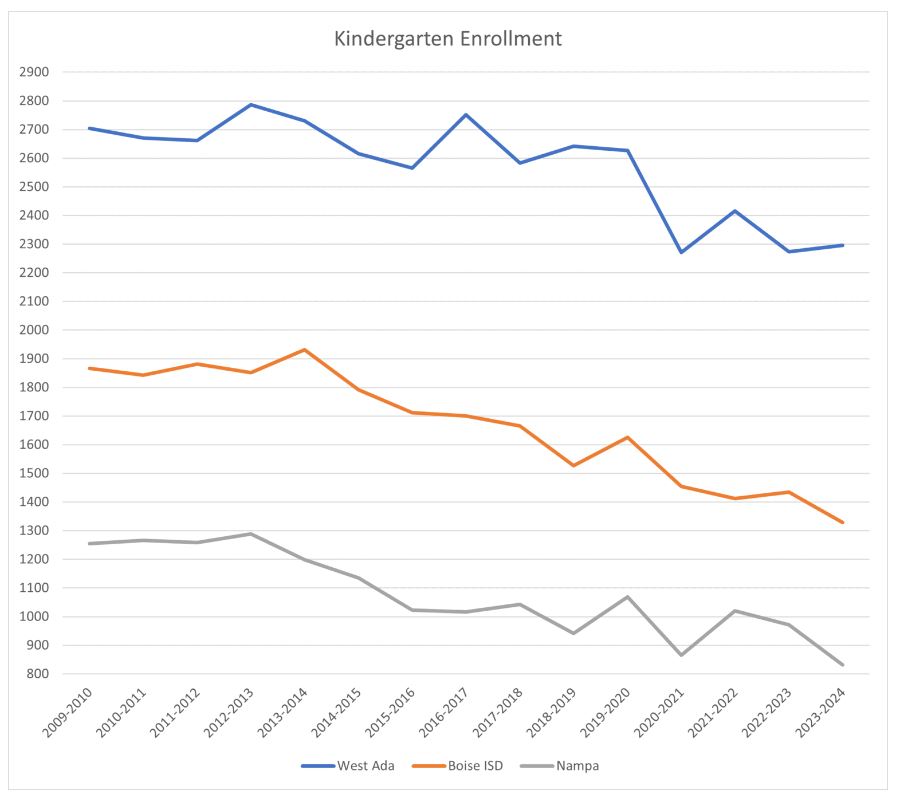
COMING EDUCATION REVOLUTION AS ENROLLMENT DECLINES IN IDAHO
By Scott Yenor
The narrative during every legislative session is that Idaho needs to spend more money on K-12 public education. But declining student populations are a big reason to avoid spending huge amounts of capital on K-12 infrastructure.
Governor Little trumpeted increasing facility spending over the next 10 years in an April 10, 2024 press release following the legislative session:
“Governor Little and the Legislature championed House Bill 521, making the largest-ever state investment in school facilities. The bill increases funding by a net of $1.5 billion over the next 10 years to ensure all districts have the resources to address unmet capital construction needs and improve student achievement.”
This investment is being made even as Idaho’s largest school districts face the prospect of losing students. Fewer youngsters mean fewer students, and Idaho’s lower grade school years — especially its kindergartens and first grades — have historically low enrollments. There were 20,655 kindergarteners attending public and charter schools statewide in 2023-2024, while every other grade had more than 22,500 students. This was Idaho’s smallest kindergarten class since 2005-2006, when Idaho had 1.43 million people (it has nearly 2 million today). As smaller classes make their way through the pipeline, school districts will inexorably shrink.
It hasn’t been like this recently. Idaho has one of the highest birth rates in America and one of the highest net in-migration rates during the last decade. Between 2017 and 2022, Idaho saw the largest increase in its child population in the country (4.4%) and the largest increase in school enrollment. Idaho had 246,521 students in 2002. It had 311,096 in 2020, a 26% increase. The number exceeded 318,000 in 2023-2024. Nearly 24% of Idaho’s population was under the age of 18 in 2022—the sixth-highest percentage in the country.
Public school enrollment in Idaho is, however, beginning to dip. As Idaho’s largest cohort of children moved through the system, districts grew. Over 25,000 babies were born in Idaho in 2007 — the largest number in state history; that number translated into over 26,000 10th graders and over 25,000 11th graders in 2023-2024. These kids will graduate in 2025. Only around 21,500 babies were born statewide in 2020 and nearly 21,000 in 2022. Idaho is beginning to experience the demographic cliff coming from falling birth rates like other states such as Michigan and Vermont and cities like Chicago, Grosse Pointe, MI, and San Diego have already felt. Other countries have been undergoing population decline for even longer.
Consider the following enrollment data from around the state.

West Ada School District, Idaho’s largest, has approximately 1,000 fewer kindergarteners and first graders than ninth graders. There are about 16,500 students in the six grades that make up K-5, while there are over 13,500 in the four grades of high school. In Boise, the second largest school district, 6.4% of students are kindergarteners, while 9.1% are tenth graders.
Nampa School District, the fourth largest, has only 841 in its current kindergarten class, down from 1,200 a decade ago. No Nampa School District grade had under 900 students since 2000-2001. Vallivue has seen tremendous growth in the past two decades, yet its current Kindergarten is its smallest grade in more than twenty years. There are 847 Vallivue 10th graders but only 647 kindergarteners.
Make no mistake: students are not running to private schools or homeschooling. Idaho ranks 42nd in the country in private school attendance (around 6% of Idaho students attend private schools), and the U.S. Census Bureau estimates Idaho’s homeschooling population is just over 6%. Idaho’s charter school population (about 10%) is also low compared to other states like California and Florida (around 12%) and Arizona (around 20%).
Some Idaho districts, reacting to enrollment declines, are trimming personnel and shedding or repurposing schools. Nampa is repurposing four schools for other uses and laying off many elementary teachers. Neither West Ada nor Boise has yet made cuts for next year, though Boise trimmed positions in 2023. Rural districts experiencing the same declines may consider consolidation or downsizing as well.
American education associations are still doing their utmost to increase spending for public schools and funnel as many students as possible into traditional public schools. This is not a time for big new construction projects. Population declines should be a factor as local communities vote on large local levies and bonds. School administration must be nimble in times of population decline because the benefits of economies of scale are decreasing. In America, nimbleness comes from school choice. School choice opponents in Idaho have succeeded in killing major school choice legislation, even as Utah, Arkansas, Iowa, and other red states have adopted the policy. There will probably always be traditional public schools–and we should work to improve them. Nevertheless, it is well past time to give parents more education options rather than consigning children to public schools by over-investing in unnecessary infrastructure and systems.